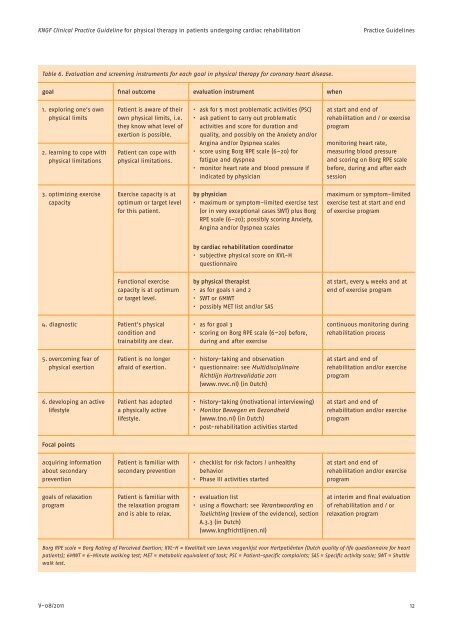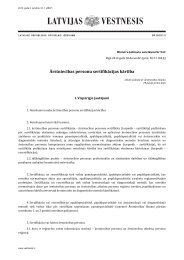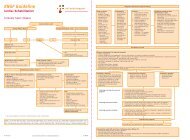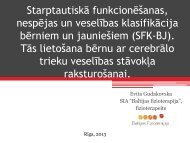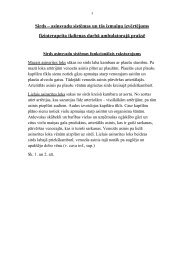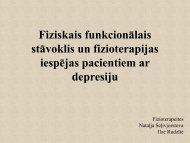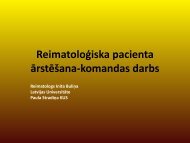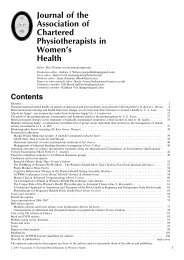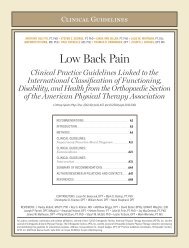KNGF Guideline Cardiac rehabilitation
KNGF Guideline Cardiac rehabilitation
KNGF Guideline Cardiac rehabilitation
Create successful ePaper yourself
Turn your PDF publications into a flip-book with our unique Google optimized e-Paper software.
<strong>KNGF</strong> Clinical Practice <strong>Guideline</strong> for physical therapy in patients undergoing cardiac <strong>rehabilitation</strong><br />
Practice <strong>Guideline</strong>s<br />
Table 6. Evaluation and screening instruments for each goal in physical therapy for coronary heart disease.<br />
goal final outcome evaluation instrument when<br />
1. exploring one’s own<br />
physical limits<br />
2. learning to cope with<br />
physical limitations<br />
Patient is aware of their<br />
own physical limits, i.e.<br />
they know what level of<br />
exertion is possible.<br />
Patient can cope with<br />
physical limitations.<br />
• ask for 5 most problematic activities (PSC)<br />
• ask patient to carry out problematic<br />
activities and score for duration and<br />
quality, and possibly on the Anxiety and/or<br />
Angina and/or Dyspnea scales<br />
• score using Borg RPE scale (6–20) for<br />
fatigue and dyspnea<br />
• monitor heart rate and blood pressure if<br />
indicated by physician<br />
at start and end of<br />
<strong>rehabilitation</strong> and / or exercise<br />
program<br />
monitoring heart rate,<br />
measuring blood pressure<br />
and scoring on Borg RPE scale<br />
before, during and after each<br />
session<br />
3. optimizing exercise<br />
capacity<br />
Exercise capacity is at<br />
optimum or target level<br />
for this patient.<br />
by physician<br />
• maximum or symptom-limited exercise test<br />
(or in very exceptional cases SWT) plus Borg<br />
RPE scale (6–20); possibly scoring Anxiety,<br />
Angina and/or Dyspnea scales<br />
maximum or symptom-limited<br />
exercise test at start and end<br />
of exercise program<br />
by cardiac <strong>rehabilitation</strong> coordinator<br />
• subjective physical score on KVL-H<br />
questionnaire<br />
Functional exercise<br />
capacity is at optimum<br />
or target level.<br />
by physical therapist<br />
• as for goals 1 and 2<br />
• SWT or 6MWT<br />
• possibly MET list and/or SAS<br />
at start, every 4 weeks and at<br />
end of exercise program<br />
4. diagnostic Patient’s physical<br />
condition and<br />
trainability are clear.<br />
• as for goal 3<br />
• scoring on Borg RPE scale (6–20) before,<br />
during and after exercise<br />
continuous monitoring during<br />
<strong>rehabilitation</strong> process<br />
5. overcoming fear of<br />
physical exertion<br />
Patient is no longer<br />
afraid of exertion.<br />
• history-taking and observation<br />
• questionnaire: see Multidisciplinaire<br />
Richtlijn Hartrevalidatie 2011<br />
(www.nvvc.nl) (in Dutch)<br />
at start and end of<br />
<strong>rehabilitation</strong> and/or exercise<br />
program<br />
6. developing an active<br />
lifestyle<br />
Patient has adopted<br />
a physically active<br />
lifestyle.<br />
• history-taking (motivational interviewing)<br />
• Monitor Bewegen en Gezondheid<br />
(www.tno.nl) (in Dutch)<br />
• post-<strong>rehabilitation</strong> activities started<br />
at start and end of<br />
<strong>rehabilitation</strong> and/or exercise<br />
program<br />
Focal points<br />
acquiring information<br />
about secondary<br />
prevention<br />
Patient is familiar with<br />
secondary prevention<br />
• checklist for risk factors / unhealthy<br />
behavior<br />
• Phase III activities started<br />
at start and end of<br />
<strong>rehabilitation</strong> and/or exercise<br />
program<br />
goals of relaxation<br />
program<br />
Patient is familiar with<br />
the relaxation program<br />
and is able to relax.<br />
• evaluation list<br />
• using a flowchart: see Verantwoording en<br />
Toelichting (review of the evidence), section<br />
A.3.3 (in Dutch)<br />
(www.kngfrichtlijnen.nl)<br />
at interim and final evaluation<br />
of <strong>rehabilitation</strong> and / or<br />
relaxation program<br />
Borg RPE scale = Borg Rating of Perceived Exertion; KVL-H = Kwaliteit van Leven vragenlijst voor Hartpatiënten (Dutch quality of life questionnaire for heart<br />
patients); 6MWT = 6-Minute walking test; MET = metabolic equivalent of task; PSC = Patient-specific complaints; SAS = Specific activity scale; SWT = Shuttle<br />
walk test.<br />
V-08/2011<br />
12


